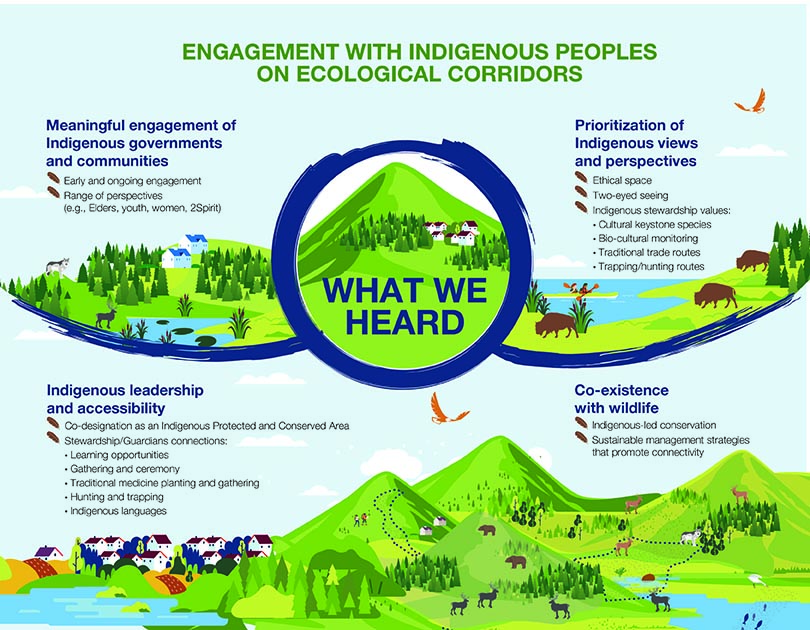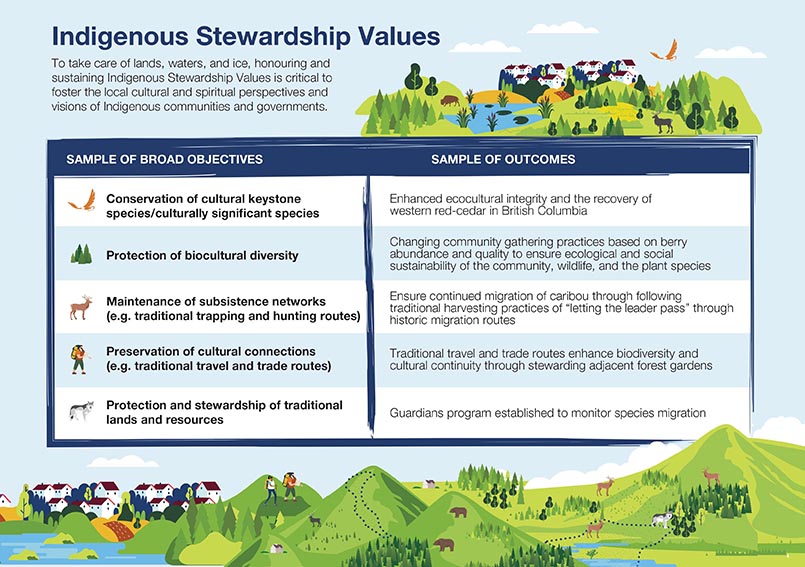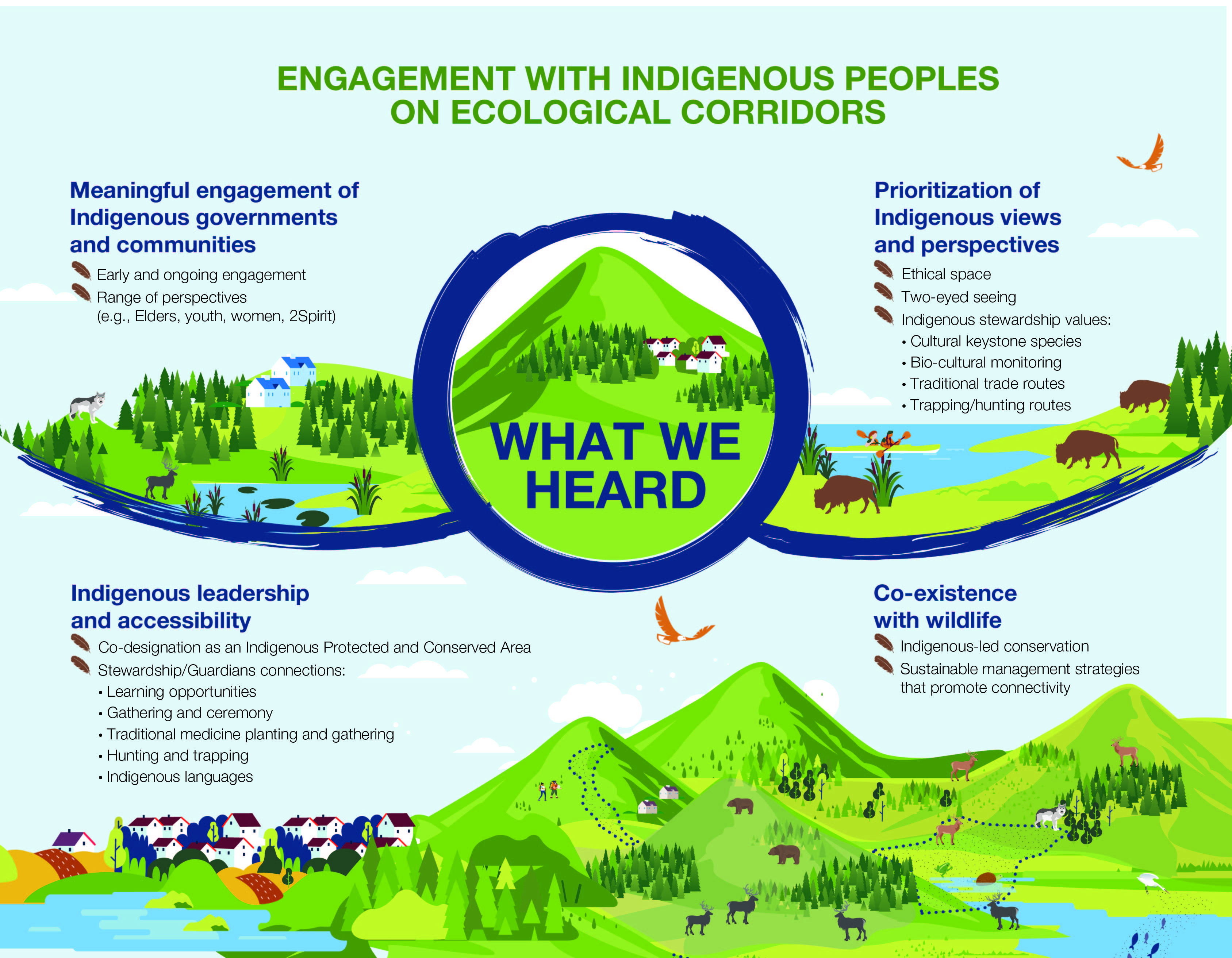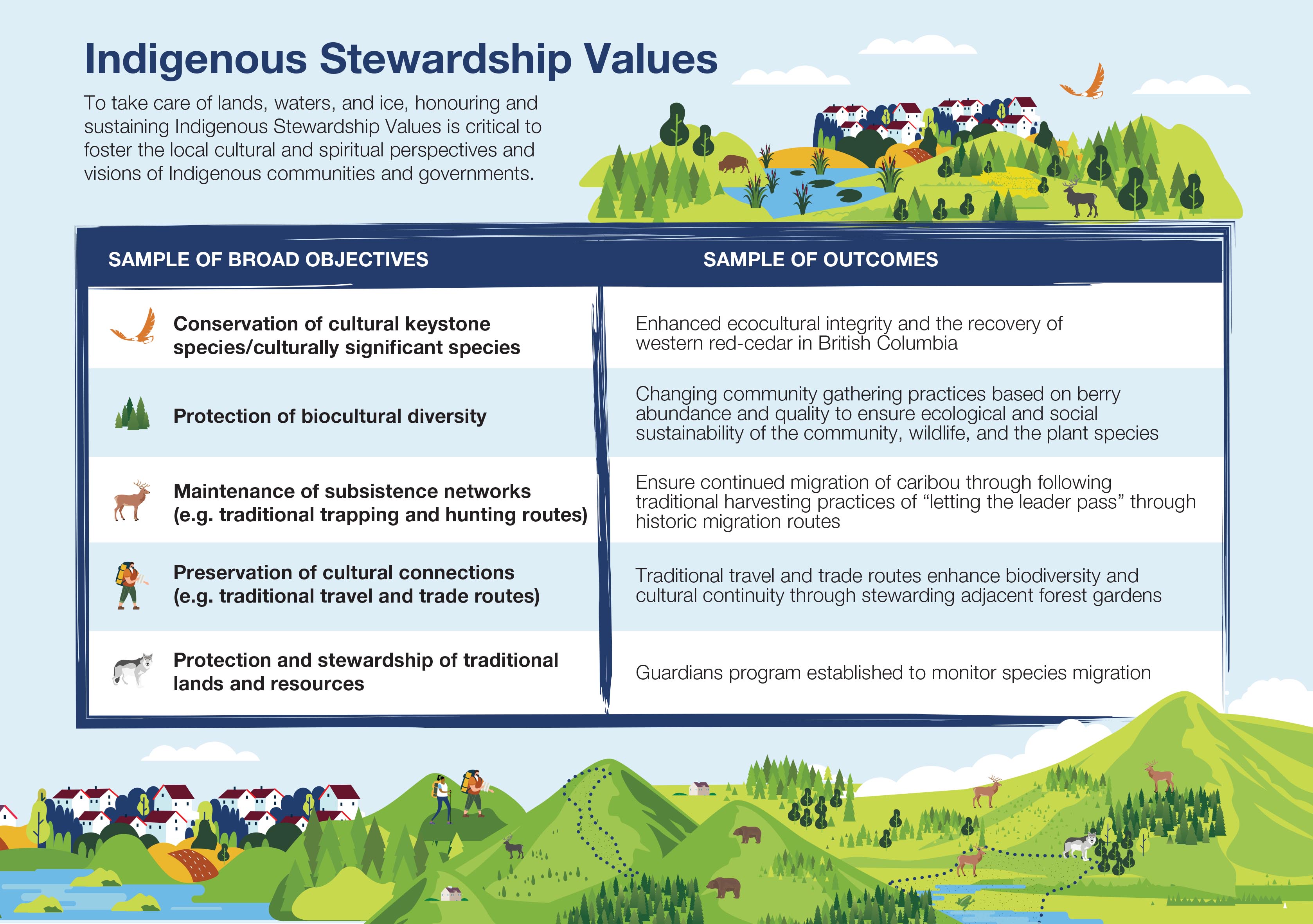Indigenous leadership in ecological corridors
One main objective of the National Program for Ecological Corridors is to promote and advance reconciliation with Indigenous peoples. The program aims to weave Indigenous and western scientific knowledge, and foster opportunities for Indigenous peoples to be stewards of the lands, ice, and waters. Relationship-building and engagement activities have taken place, and are ongoing, including with:
- national and regional Indigenous organizations and governments
- Indigenous-led conservation networks and initiatives
The National Program for Ecological Corridors supports Indigenous leadership and stewardship by recognizing Indigenous stewardship values as a priority goal for corridors. The program has also supported an Indigenous-led pilot project and other projects that are engaging and collaborating with local Indigenous communities on the stewardship of these lands.
Engagement with Indigenous peoples on ecological corridors
What we heard
Weaving Indigenous Knowledge and perspectives into all aspects of the National Program for Ecological Corridors is a priority. To go about this work in a good way, several Indigenous communities, governments, individuals, and organizations were engaged to seek input.
The program also sought public input on ecological corridors through the 2020 and 2023 Minister’s Round Table.
Through this engagement, a wealth of input and feedback was received on the topics of:
Meaningful engagement of Indigenous governments and communities
- Early and ongoing engagement
- Range of perspectives (for example, Elders, youth, women, 2Spirit)
Prioritization of Indigenous views and perspectives
- Ethical space
- Two-eyed seeing
- Indigenous stewardship values:
- Cultural keystone species
- Bio-cultural monitoring
- Traditional trade routes
- Trapping/hunting routes
Indigenous leadership and accessibility
- Co-designation as an Indigenous Protected and Conserved Area
- Stewardship/Guardians connections:
- Learning opportunities
- Gathering and ceremony
- Traditional medicine planting and gathering
- Hunting and trapping
- Indigenous languages
Co-existence with wildlife
- Indigenous-led conservation
- Sustainable management strategies that promote connectivity

Engagement with Indigenous peoples on ecological corridors — Text description
A graphic displays the “What We Heard” text listed above, with some illustrations.
The infographic has text in each quadrant describing what was heard according to the four categories outlined above. A dark blue paintbrush stroke circles an illustration of a mountain in the middle of the graphic. The mountain has two patches of forest around a small town halfway up its side. The title “What We Heard” is at the base of the mountain. The top and bottom halves of the infographic are separated by a swooping dark blue paintbrush stroke.
Above the paintbrush extending to the left of the circle is an illustrated scene of a small town, symbolized by two white houses, surrounded by forest. In the foreground is a small hill that has a pond at its base. A wolf stands at the top of the hill, and a caribou at the base. The pond has water lily pads floating on it, and cattails surrounding it.
Above the paintbrush extending to the right of the circle is an illustrated scene of a lake with grasslands surrounding it, and a small patch of forest to the far right. There are three buffalo grazing on the grass, and a couple patches of cattails can be seen by the lake. There are kayakers in a 2-person kayak by the short of the lake.
At the bottom of the graphic, spanning its width, is a scene depicting an ecological network. To the left is a large town of white houses with a multi-laned road in front of it. In the foreground at the left is a small lake. The scene transitions from the town on the left, to a patch of mixed forest, to a mountainous scene on the right. Patches of mixed and coniferous forests can be seen interspersed across the base of the mountains. There is a lake at the bottom right. A variety of animals are shown across the mountains; two bears are on one mountain, caribous are at the base and by the lake, three deer and a wolf are on a mountain in the background, two hikers are on another mountain, and a turtle, frog, heron and fish can be seen in the lake at the right. Two speckled patches outlined by a dotted line overlay the mountain scene. One snakes up the mountain with the hikers, and the other covers the valley between two mountains where the lake is. These patches are meant to represent ecological corridors connecting protected and conserved areas, or other unprotected habitats.
View image
Download Engagement with Indigenous peoples on ecological corridors (PDF, 0.5 MB)
Indigenous stewardship values
To take care of lands, waters, and ice, honouring and sustaining Indigenous stewardship values is critical. This fosters the local cultural and spiritual perspectives and visions of Indigenous communities and governments when creating an ecological corridor.
Parks Canada has adapted the International Union for Conservation of Nature’s (IUCN) definition of ecological corridors to better reflect the reality that Indigenous peoples have been stewarding the lands and waters since time immemorial: “A clearly defined geographical space where governance, management and stewardship over the long term maintain or restore effective ecological connectivity while upholding Indigenous stewardship values”. The objective of upholding specific Indigenous stewardship values works in harmony with the objectives of the National Program for Ecological Corridors.
Sample of broad objectives and outcomes
The objectives of an ecological corridor are flexible to ensure relevance for the local Indigenous community. The following represent a sample of broad objectives and outcomes of Indigenous stewardship values for ecological corridors:
| Sample of broad objectives | Sample of outcomes |
|---|---|
| Conservation of cultural keystone species/culturally significant species | Enhancing ecocultural integrity and the recovery of western red-cedar in British Columbia |
| Protection of biocultural diversity | Changing community gathering practices based on berry abundance and quality to ensure ecological and social sustainability of the community, wildlife, and the plant species |
| Maintenance of subsistence networks (for example, traditional trapping and hunting routes) | Ensure continued migration of caribou through following traditional harvesting practices of “letting the leader pass” through historic migration routes |
| Preservation of cultural connections (for example, traditional and trade routes) | Traditional travel and trade routes enhance biodiversity and cultural continuity through stewarding adjacent forest gardens |
| Protection and stewardship of traditional lands and resources | Guardians program established to monitor species migration |

Indigenous stewardship values — Text description
A graphic displays the Indigenous stewardship value information described above through a table, with some illustrations around the table.
Above the table and on the right of the infographic is an illustrated scene of a hilly landscape that includes a large town with a road behind a more natural, undisturbed foreground. In front of the town is a pond with a patchwork of hilly grasslands and mixed forests around it. The pond has cattails around it, and lily pads float on its surface. A buffalo grazes on grasses to the left of the pond, a caribou is between patches of forest on the right of the pond, and a bald eagle soars overhead.
Below the table, and spanning the width of the graphic, is a scene depicting an ecological network. To the left is a large town of white houses with a multi-laned road in front of it. In the foreground at the left is a small lake. The scene transitions from the town on the left, to a mountainous scene in the middle and right. Patches of mixed and coniferous forests can be seen interspersed across the base of the mountains and in the valley between them. A variety of animals are shown across the mountains; bears are on one mountain in the foreground, a caribou is at the base of another mountain, deer and a wolf are at the base of a mountain to the right, and two hikers are between the town and the mountains. Two speckled patches outlined by a dotted line overlay the mountain scene. One snakes up the mountain with the caribou, and the other covers the front portion of the valley. These patches are meant to represent ecological corridors connecting protected and conserved areas, or other unprotected habitats.
View a larger image
Download Indigenous stewardship values (PDF, 1.5 MB)
- Date modified :

